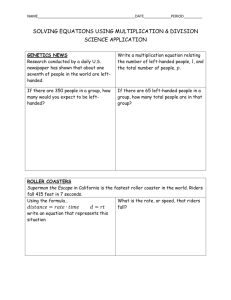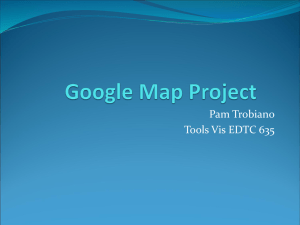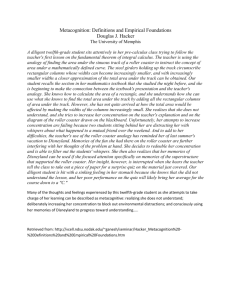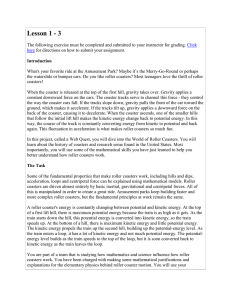Chapter Thirteen
advertisement
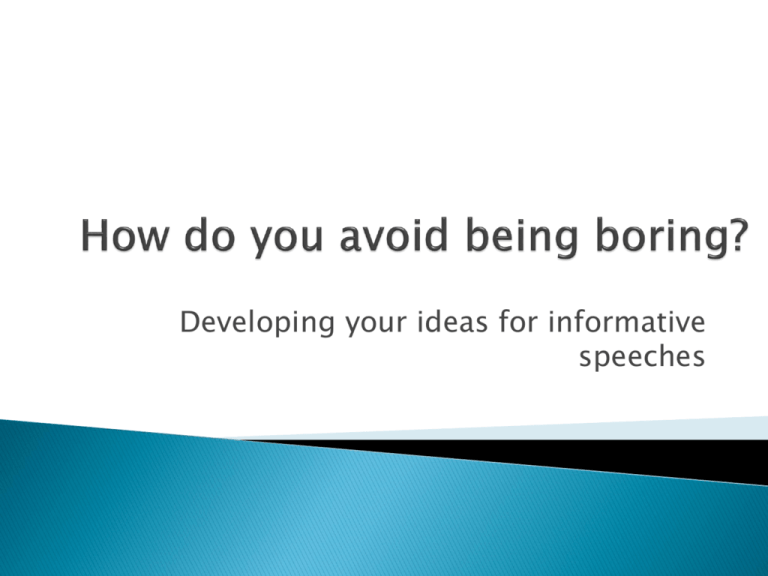
Developing your ideas for informative speeches Al Gore excerpt (attention step) Chili Peppers excerpt (full CARRP) Relate the topic to the audience State the importance of your topic Startle the audience Arouse curiosity Question the audience Begin with a quotation Tell a story Establish common ground Use humor Refer to the speech situation or context Use an analogy Do an action Do whatever you do with eye contact and confidence Clarity of Thought/Structure Engaging Audience Interest ◦ Supporting Materials Chapter 14 Advice ◦ Don’t overestimate what the audience knows ◦ Relate the topic directly to the audience ◦ Don’t be too technical ◦ Avoid abstractions ◦ Personalize your ideas How about Edible Insects? Specific Purpose: To inform my audience about the uses of insects in our diet. Central Idea: Insects have been, are and will continue to grow as an important part of the human diet because of their nutritional value. I. Insects are already a part of our daily diet. II. Insects have been used by humans as a food source throughout history. III. Insects have impressive nutritional value. IV. Insects are likely to become a greater part of our diet in the future. And tell them something they can use W. p. 38 Scientific Monthly 1941 study took images of people sneezing at 1,260 frames a second particles traveled anywhere from 61 to 94 feet per second! Attention: curiosity is aroused in #1-3 through vivid description. Relating to Audience is limited to putting the listener into the speech with “you” and “your.” Topic is clearly revealed in the first sentence of paragraph 4. Credibility: personal experience? No expertise at all here, some goodwill? Preview: clearly signals three main points. I. Sneezing can be understood in terms of the superstitions surrounding it throughout history. II. Sneezing can be understood as the body's complex reaction to a number of stimuli from pollen to strong emotion. III. Sneezing can be understood as something that can be done safely and politely. First Main Point, paragraphs 6-12 ◦ Extended Example: story of Xenophon from the Concise Dictionary of Ancient History--nice details ◦ Extended examples across cultures: Zulu, India, western culture, (South Pacific--brief). All from Encyclopedia of Occult Sciences, Superstitions, and Folklore. ◦ Also increased credibility with citation of info from Science magazine. Second Main Point, paragraphs 13-17 ◦ Stat. 104 miles an hour--no citation; problem Fix it ◦ Examples based on the discussion in the New York Times. ◦ Example of June Clark--interesting, but no source cited. Third Main Point, paragraphs 18-19 ◦ Information in paragraph 18 is not cited. ◦ Quote from Jane Brody in the New York Times. Introduction: ◦ "you," and "your" ◦ preview is clear but not overly blatant. First Main Point: ◦ Concrete details and interesting word choices help to bring the story to life. ◦ The strong word choices continue: "sneezing,” is called "the nose's most conspicuous function." ◦ The language also continues to try to relate to the audience: "If you were walking down the dusty streets of Karim Nagar." Second Main Point: ◦ He avoids getting overly technical; where it borders on technical he does it for humorous effect as in "overly active equilibriating mechanism." ◦ Colorful word choice continues: "rampaging predators," and "banishing intruders." ◦ Again, he addresses the audience: "If a man lunged at you with a knife.” Accuracy means making sure you have the right word for the idea or object. Clarity means making sure you have the right word for your audience in terms of their knowledge base and listening skills. Appropriateness means that you have the right word for your audience in terms of their attitudes toward the situation, topic and speaker. Take a hint from Stephen Colbert, Wikipedia is not always reliable Identify author Identify sponsoring organization ◦ if you can’t identify author or sponsoring org., don’t use the document! Determine recency ◦ copyright date ◦ publication date ◦ date of last revisions Will using this source help or hurt my credibility? Build on the sense of structure developed in the Paired Perspectives Speech Find engaging materials--examples are especially helpful Integrate them nicely into the presentation Use language that is clear and lively Develop a delivery style to enhance the material you have prepared. See you Monday What are the components of good visual aids and delivery and how do I improve mine? Visual aids can add a great deal to the speech when nicely integrated. ◦ But don’t let your visual aid substitute for the speech. Visual aids can add attention and interest, but they can also distract. ◦ Never pass around a visual aid during a formal speaking engagement. ◦ Show it while talking about it; but leave it up long enough for all listeners to take in ◦ Use common sense (no fires, weapons, live animals, no graphic images, etc..) Percent of movie-industry revenues 100 Movie-industry revenues 80 TV & home video 60 40 Box office 20 0 1981 1988 Year Ch. 13-5 1997 Aim for a professional look. ◦ Make sure whatever aid you use is large enough for all to see. Practice delivery with it. Know how you can best refer to it while you speak. Practice the mechanics of it. Additional tips in T ch. 13 and W p. 35. HEART LINE LIFE LINE HEAD LINE LINE OF DESTINY Ch. 13-4 Roller Coaster Speech (video) Gore speech (PowerPoint+) I. Roller coasters offer a thrill that American’s love. II. Roller coasters have had an up-and-down history. III. Roller coasters at today’s parks offer a wide variety of designs and thrills. IV. Roller coasters of the future will feature new developments like the pipeline. Preview: ◦ “Today I would like to discuss America’s addiction to the thrill of roller coaster riding and then present to you the past, present and future of the roller coaster….” Connectives ◦ Thrill-seeker or not, the question most of us ask ourselves as we are nearing the top of a coaster’s incline is, “Who would ever build such a contraption?” (transition) ◦ “Let’s take a look at some of today’s hottest rides.” “First,” “Next we travel,” “Now we venture,” “Finally,” (signposts) ◦ “So far we have seen….” (internal summary) ◦ “In conclusion…” Support Materials ◦ Smithsonian Magazine; Professor Farley; leading designer of roller coasters; and video Critique strengths and weaknesses A scientific approach to delivery Gilbert Austin’s Chironomia,1806 Elocutionists had rules for ◦ ◦ ◦ ◦ Stance Broad gestures Fingers Eyebrows Delsarte’s system introduced in the 1880s kept this alive The Speaker’s Body Matters ◦ Personal appearance is important. ◦ Physical stance is important. ◦ Gestures, eye contact and facial expressiveness are important. ◦ “People trust their ears less than their eyes.” The Speaker’s Voice Matters ◦ Pitch, rate, pauses, inflection, pronunciation, and articulation are the critical terms. ◦ Paralanguage refers to the manipulation of these variables to make a single sentence have a variety of meanings. Rehearse the speech out loud with the preparation outline. Develop a speaking outline (see workbook pp. 29-31) Practice aloud using the speaking outline (and put it down too) Polish and refine your delivery by practicing with others or recording your performance. Arrange for a dress rehearsal so you are familiar with your space. To do all of this requires two things ◦ finish developing the speech content early ◦ working with anxiety Mark Twain Pudd’nhead Wilson, 1894 is very common ◦ James McCroskey, a leading communication apprehension researcher, finds that 70-75% of American’s say they experience anxiety is typically a response to the release of the hormones adrenaline and cortisol ◦ an adrenaline rush should feel good and be useful ◦ as adrenaline gives out and the stressor remains cortisol rises as adrenaline falls and there we have some physical and mental discomfort is triggered by OLD brain wiring ◦ “fight or flight” response ◦ Speech trainer Mary Fensholt says: “The fear of public speaking is more than anything a fear of being eaten” Think positively ◦ Use visualization: imagine your success ◦ The goal is communication, not perfection Prepare ◦ Work on content early; choose something you know ◦ Work especially hard on introduction On your speaking day, be proactive. ◦ Do simple muscle relaxation ◦ Create an outlet for extra energy before or during ◦ Take slow deep breaths ◦ Bring some water to drink ◦ Use Visual Aids ◦ Use eye contact with members of the audience I don’t have any strengths as a speaker. I’m too nervous to do well. THEY will think I’m stupid (boring, inarticulate) I don’t have anything important to say. It has to be a perfect performance. I can do __X__ well. A little nervousness can help! ◦ It is a source of energy My audience wants me to succeed. I have prepared well and will give my best. I can share what I know. They want you to succeed! They feel your anxiety They are eager to listen and learn They hope to be taken by your enthusiasm and excitement about the topic They want you to succeed! They feel your anxiety They are eager to listen and learn They hope to be taken by your enthusiasm and excitement about the topic Build the skeleton first [the outline] Find engaging materials—examples are especially helpful ◦ What’s the big goal, the take away idea? ◦ What are the main points everyone should know? ◦ How can you structure your ideas to make them easier to follow and retain? ◦ What kinds of connectives can drive the points home? ◦ Integrate them nicely into the presentation ◦ Use language that is clear and lively Develop a delivery style to enhance the material you have prepared Use Positive Preparation The thinking speaker is able ◦ to respond to feedback ◦ to adjust to the situation and interference ◦ to achieve conversational delivery ◦ to help the audience think that this is what the speaker want to be doing right now Eleanor Roosevelt
